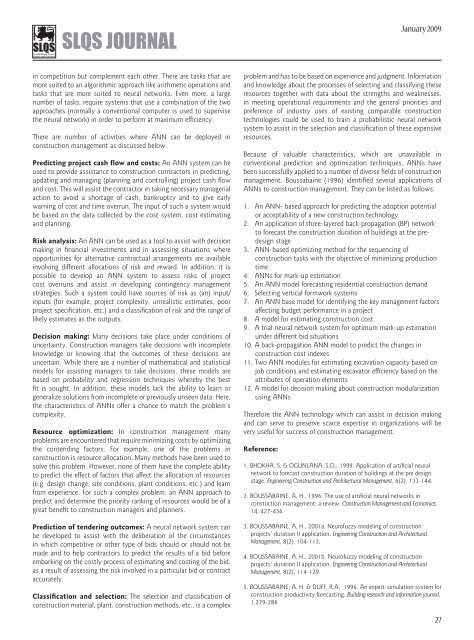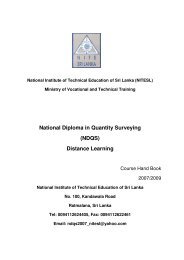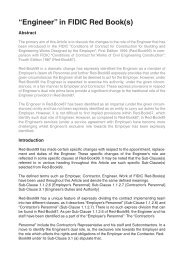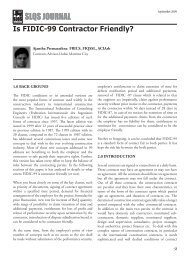SLQS-Journal Vol. 1 - Slqs-uae.org
SLQS-Journal Vol. 1 - Slqs-uae.org
SLQS-Journal Vol. 1 - Slqs-uae.org
You also want an ePaper? Increase the reach of your titles
YUMPU automatically turns print PDFs into web optimized ePapers that Google loves.
<strong>SLQS</strong> JOURNALJanuary 2009in competition but complement each other. There are tasks that aremore suited to an algorithmic approach like arithmetic operations andtasks that are more suited to neural networks. Even more, a largenumber of tasks, require systems that use a combination of the twoapproaches (normally a conventional computer is used to supervisethe neural network) in order to perform at maximum efficiency.There are number of activities where ANN can be deployed inconstruction management as discussed below.Predicting project cash flow and costs: An ANN system can beused to provide assistance to construction contractors in predicting,updating and managing (planning and controlling) project cash flowand cost. This will assist the contractor in taking necessary managerialaction to avoid a shortage of cash, bankruptcy and to give earlywarning of cost and time overrun. The input of such a system wouldbe based on the data collected by the cost system, cost estimatingand planning.Risk analysis: An ANN can be used as a tool to assist with decisionmaking in financial investments and in assessing situations whereopportunities for alternative contractual arrangements are availableinvolving different allocations of risk and reward. In addition, it ispossible to develop an ANN system to assess risks of projectcost overruns and assist in developing contingency managementstrategies. Such a system could have sources of risk as (an) input/inputs (for example, project complexity, unrealistic estimates, poorproject specification, etc.) and a classification of risk and the range oflikely estimates as the outputs.Decision making: Many decisions take place under conditions ofuncertainty. Construction managers take decisions with incompleteknowledge or knowing that the outcomes of these decisions areuncertain. While there are a number of mathematical and statisticalmodels for assisting managers to take decisions, these models arebased on probability and regression techniques whereby the bestfit is sought. In addition, these models lack the ability to learn <strong>org</strong>eneralize solutions from incomplete or previously unseen data. Here,the characteristics of ANNs offer a chance to match the problem’scomplexity.Resource optimization: In construction management manyproblems are encountered that require minimizing costs by optimizingthe contending factors. For example, one of the problems inconstruction is resource allocation. Many methods have been used tosolve this problem. However, none of them have the complete abilityto predict the effect of factors that affect the allocation of resources(e.g. design change, site conditions, plant conditions, etc.) and learnfrom experience. For such a complex problem, an ANN approach topredict and determine the priority ranking of resources would be of agreat benefit to construction managers and planners.Prediction of tendering outcomes: A neural network system canbe developed to assist with the deliberation of the circumstancesin which competitive or other type of bids should or should not bemade and to help contractors to predict the results of a bid beforeembarking on the costly process of estimating and costing of the bid,as a result of assessing the risk involved in a particular bid or contractaccurately.Classification and selection: The selection and classification ofconstruction material, plant, construction methods, etc., is a complexproblem and has to be based on experience and judgment. Informationand knowledge about the processes of selecting and classifying theseresources together with data about the strengths and weaknesses,in meeting operational requirements and the general priorities andpreference of industry uses of existing comparable constructiontechnologies could be used to train a probabilistic neural networksystem to assist in the selection and classification of these expensiveresources.Because of valuable characteristics, which are unavailable inconventional prediction and optimization techniques, ANNs havebeen successfully applied to a number of diverse fields of constructionmanagement. Boussabaine (1996) identified several applications ofANNs to construction management. They can be listed as follows:1. An ANN- based approach for predicting the adoption potentialor acceptability of a new construction technology2. An application of three-layered back-propagation (BP) networkto forecast the construction duration of buildings at the predesignstage3. ANN-based optimizing method for the sequencing ofconstruction tasks with the objective of minimizing productiontime4. ANNs for mark-up estimation5. An ANN model forecasting residential construction demand6. Selecting vertical formwork systems7. An ANN base model for identifying the key management factorsaffecting budget performance in a project8. A model for estimating construction cost.9. A trial neural network system for optimum mark-up estimationunder different bid situations10. A back-propagation ANN model to predict the changes inconstruction cost indexes11. Two ANN modules for estimating excavation capacity based onjob conditions and estimating excavator efficiency based on theattributes of operation elements12. A model for decision making about construction modularizationusing ANNsTherefore the ANN technology which can assist in decision makingand can serve to preserve scarce expertise in <strong>org</strong>anizations will bevery useful for success of construction management.Reference:1. BHOKHA, S. & OGUNLANA, S.O., 1999. Application of artificial neuralnetwork to forecast construction duration of buildings at the pre designstage. Engineering Construction and Architectural Management, 6(2), 133-144.2. BOUSSABAINE, A, H., 1996. The use of artificial neural networks inconstriction management: a review. Construction Management and Economics,14, 427-436.3. BOUSSABAINE, A, H., 2001a. Neurofuzzy modeling of constructionprojects’ duration II application. Engineering Construction and ArchitecturalManagement, 8(2), 104-113.4. BOUSSABAINE, A, H., 2001b. Neurofuzzy modeling of constructionprojects’ duration II application. Engineering Construction and ArchitecturalManagement, 8(2), 114-129.5. BOUSSABAINE, A. H. & DUFF, R.A. 1996. An expert-simulation system forconstruction productivity forecasting. Building research and information journal,1,279-28627





